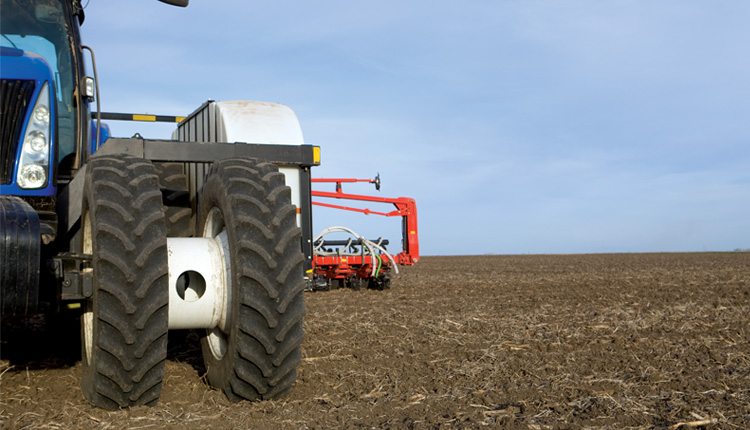As companies continue to innovate and look at different ways to deliver what the seed needs to reach its maximum potential, some create synergies in the furrow.
We all know that the seed, this tiny little round thing that fits between your thumb and forefinger, is a finite space. For the past decade, seed treatments have been a point of focus for scientists and seed companies as they look to deliver crop inputs more precisely, giving the seed exactly what it needs right where it needs it. Now, the seed is loaded up and researchers are starting to look at and evaluate, what can live on the seed and what can live in the furrow.
They are also asking if unique synergies can be created between the two.
“We’re always looking for ways to bring the best solutions to growers,” says Caren Schmidt, BASF technical marketing manager.

New Partnerships
BASF and FMC recently announced a partnership to develop several new in-furrow products that integrate the technologies of FMC’s unique, market-leading LFR insecticide and BASF’s gold standard fungicide portfolio.
Through the partnership, BASF will launch Manticor LFR In-Furrow fungicide/insecticide this spring.
“As an industry, we need new tools to push yield higher without using more of our natural resources,” says Scott Stout, BASF corn fungicide products manager. “These kinds of collaborations help get us to that goal.”
In-furrow fungicides offer many benefits from improved root growth and seedling vigor to improved cold tolerance and higher yields, Schmidt says.
“Losing yield potential at planting can never be made up for later in the season,” Schmidt explains. “So with an in-furrow product that protects against diseases, improves cold tolerance and protects against soil insects, including corn rootworm, that can really help get that crop out of the ground more quickly and more uniformly, and set it up for the highest yield potential.”
The seedlings benefit from an in-furrow application because of the fungicide component, so the technology that is in Headline, she explains, helps protect against diseases … then the insecticide component helps the seedlings to get out of the ground and protect against pests found in the soil.
This helps to improve early seedling vigor, enhance root growth and more uniform emergence — all leading to higher yield potential.
FMC and BASF aren’t the only ones focused on providing the seed protection in the furrow.
West Central Distribution, in Willmar, Minn., has partnered with BASF, Dow AgroSciences, FMC and Nufarm and created Leaders of In-Furrow Technology, or LIFT, to educate the agricultural industry about the benefits of an in-furrow system that includes a total program of crop nutrients, plant health products, fertilizer compatible insecticides and customized seed treatments.
West Central offers the LIFT package to retailers in 23 Corn Belt states.
“Against the backdrop of lower commodity prices and the intensified focus on production techniques, LIFT capitalizes on new findings in nutrient-efficiency management and delivery technology,” says Dean Hendrickson, LIFT vice president of marketing.

Delivering Nutrients
In the area of plant nutrition, Brian Kuehl, West Central director of product development, says there have been recent developments with fertilizers possessing new or different combinations of plant food analyses with advancements in the science of formulating fertilizers.
“Many opportunities still exist in providing the right amount of the right nutrients at the right place and time,” he says, explaining that starter fertilizer was one of the first attempts to recognize that nutrients placed close to the developing seedling can provide the young plants with easy access to important nutrients at a relatively stressful time.
Kuehl says that starter fertilizers take advantage of placement, formulation, and timing to provide developing seedlings with important nutrients when and where they need them.
“Modern liquid formulations are more easily and conveniently metered and are also capable of being placed in the furrow with the seed,” he says. “This has opened the door for the ultimate in early seedling access to important nutrients.
“Placing nutrients in the furrow with the seed means immediate access to certain macro and micronutrients that assist with the enzymatic breakdown of seed starches resulting in quicker access to energy reserves and faster germination and emergence. Additionally, placement in the furrow requires minimal additional iron or plumbing on the planter compared to a more traditional 2 x 2 placement.”
When one considers the agriculture revolution of the last century, there were significant crop yield advancements made due to major advancements in farming equipment, fertilizers, pest control products, genetics, and most recently genetic engineering.
Kuehl says that over the next century, we will be asked to continue this agricultural revolution and this will certainly require continued synergies across agricultural arenas.
Under Achieving?
But one University of Illinois plant physiologist points out that today’s elite corn genetics have the potential to hit 400 and 500 bushels per acre. It’s helping farmers figure out how to preserve the yield potential that already exists.
Fred Below points to national corn yield contest winners to illustrate how much potential today’s corn genetics offer.
“There’s a huge yield gap between the yields most growers get and what is possible,” says Below.
Last year, the winning yield in every category of the National Corn Growers Association yield contest exceeded 300 bushels per acre. Six winners topped 400 bushels per acre, and the overall winner surpassed 500 bushels per acre.
“We are starting to see the synergistic effect of where a fungicide combined with an insecticide and a starter fertilizer enhances and protects the plant or seedling growth,” Below adds. “Having the nutrients there can start the plant off on a faster growth trajectory.”
Kuehl agrees.
“In-furrow placement of crop inputs fits into this strategy perfectly when you consider that it not only provides excellent placement opportunity for nutrients, but it also provides a mechanism for the placement of other important synergistic crop inputs including fungicides, insecticides, and/or biostimulants to provide for optimum seedling protection,” Kuehl explains.
Alternative Developments
A part of these new developments that will help lead the next agricultural revolution is advancements made in the biologicals sector.
Lamar Buckelew, FMC Agricultural Solutions product development manager, says getting a crop off to its strongest start is essential in crop production, and in-furrow technologies remain one of the most talked about topics to achieve that goal.
“Traditional chemistries and delivery systems are valuable tools in the process, but the new frontier in at-plant technologies is the development of biological products,” Buckelew says. “Biologicals offer alternative modes and mechanisms of action to protect plants from pests and pathogens as well as boost outputs.”
From venture capitalists to the largest crop protection companies, investment in this arena is increasing rapidly to discover and define the vast benefits that biological ingredients bring to this market.
Biological development programs are producing a wide range of commercial products, including biostimulants, biofungicides, bioinsecticides and bionematicides. All of these products contain living organisms.
Buckelew says a commonly used biological, either through direct application or contained within transgenic plants, is Bacillus thuringiensis (Bt), which forms crystals in the mid-gut of insects after ingestion causing their death.
Other bacterial strains might colonize around developing roots, creating a biofilm that protects the plant from pathogens. He says these growing colonies last longer than seed treatments to provide protection while the plant is growing.
Ethos XB Insecticide/Fungicide, introduced by FMC in 2016, combines a synthetic insecticide with a biological fungicide. It produces trillions of spores of living bacteria per acre that germinate when they get in the soil. These spores colonize around the developing roots, creating a biofilm that protects the roots from plant pathogens trying to attack them.
Buckelew says that other biologicals work less directly. Some soil amendments, for example, enhance root systems, leading to better nutrient and water uptake or by solubilizing nutrients like phosphorus, making them more available for plant uptake.
FMC entered the soil amendment market this year with an in-furrow product called VGR Soil Amendment. Its microbes solubilize phosphorus and make more nutrients available for the roots. The microbes also work to improve water uptake, resulting in a faster growing and healthier plant. VGR Soil Amendment tank mixed with Capture LFR Insecticide showed a 9.1 bushel per acre yield advantage over untreated fields, and a 3.9 bushel advantage over Capture LFR Insecticide alone.
According to Buckelew, FMC is on the leading edge of a potential crop protection paradigm shift away from mostly synthetic chemistries and toward biological products.
“Decreased synthetic chemistry development with increased research and development in biologicals will drive this shift, and it is exciting to be part of this leading-edge change and seeing where it goes,” he says.
Ultimately, biologicals offer a promise of pest management through living organisms in a way some consider more sustainable in the long term than some of the current options available to growers.
Buckelew says what is most interesting is how the influx of spending in this area will undoubtedly have beneficial side effects in areas we might not expect. “Likely there will be advances in microbial selection markers that will allow for faster development of agriculturally active biological strains, he says.
Learn More
On Jan. 19, Seed World will host a webinar that digs into the furrow to explore what new and innovative products companies are working with and how farmers should use them. You’ll have the chance to ask questions and hear firsthand from companies working on new novel production in this area. The webinar will be held at 1 p.m. Eastern. There is no cost to register, and registration can be done online at SeedWorld.com/webinar.











